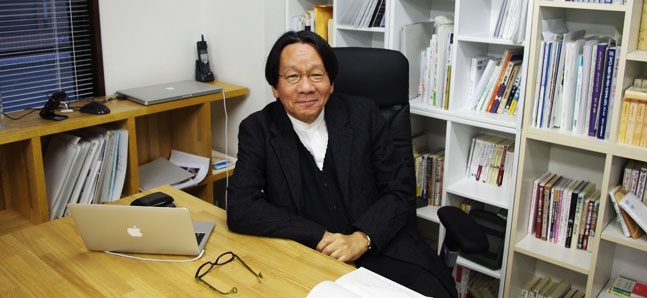
Posted: Thu Mar 24 2011
In light of the unprecedented destruction caused by the Tohoku Earthquake, Time Out Tokyo spoke to Shigeru Aoki, an architect and professor at Tokyo Metropolitan University Center for Priority Areas known for reusing as much as 80 per cent of an existing building’s materials through a practice he calls ‘refinement architecture’. He gave us an architect’s perspective on the recent devastation.
Where were you when the earthquake struck?
I heard the news about the earthquake in Hiroshima, while I was on my way back to Kyushu after a day spent working in Hamamatsu. I tried to phone our Tokyo office but couldn’t get through: it was all very worrying.
Seeing the destruction on the news, what were your initial impressions?
It was incredible. I felt overcome by a feeling of despair. There may be little we can do in the face of such a tremendous force of nature, however, in order to progress, we have to do what we can. Although more a topic for civil engineers than architects, I think the recent disaster could lead to the development of a series of giant wave dissipating blocks. It’s not something I’ve given a lot of thought to yet, but one idea could involve placing a series of giant board-like objects in the sea like dominoes to effectively dissipate wave energy. I think that, in the future, we’ll see the development of a number of new ideas that could potentially be used to generate electricity from wave energy and, in the case of an emergency, play an important role in averting another disaster.
Encasing Japan within a series of giant board-like objects, you mean?
Not so much encasing Japan within them - rather placing the boards in areas vulnerable to tsunamis. Mechanisms like these could one day even be used as an alternative to nuclear power. Creating something that could not only dissipate the energy of large waves but also turn that energy into useable electricity is something that seems like it could well be worth looking into.
Some of the images shown on the news were of areas that were already known to be at risk of tsunamis and actually had breakwaters already in place. However, the tsunami still swept on to destroy everything in its path…
The role of our current breakwaters is primarily to try and stop waves. However, it’s obvious that they aren’t enough to stop a tsunami. Instead I think we need to switch to mechanisms aimed at weakening or dissipating wave energy before it reaches us. Also, in areas hit by the tsunami, over the next few months we’ll be looking into why, in spite of many buildings being washed away, some buildings remained in place. The results of this kind of research could, I think, potentially shed some light on how best to develop mechanisms that can guard against wave energy in the future.
Has there been research of that nature previously?
Not as far as I know. The thinking up until now has been to try and stop waves. However, rethinking things is going to cost an enormous amount of money, so whilst we’re at it, as I mentioned earlier, it’s probably a good idea to also consider solving a second problem at the same time – the problem of power generation – in order to try and offset some of the cost of developing a solution.
Is there anything you can do personally to help the situation?
My work is primarily concerned with renewing buildings, which also involves making them earthquake resistant and ensuring long-term safety. However, there’s little I can do to help protect Japan from tsunamis. In that respect, it’s our country’s civil engineers who hold the power. The force with which this recent tsunami simply destroyed everything in its path was really unprecedented. Nobody expected such a thing possible, that such a catastrophe could stretch across three prefectures was previously unimaginable.
Listening to the various televised reports, one of the things I couldn’t help thinking was a bit odd was that, although this was the largest earthquake recorded in Japan, when looked at from a global perspective, it was only the fourth largest, and yet some of our buildings are designed to only withstand a magnitude of 8.0, rather than a worst-case scenario...
That’s a question that’s concerned with the ambiguity of how Japan, as a nation, makes decisions. I think that one of the reasons people shy away from the work I do – refinement architecture – is because they don’t want to shoulder the responsibility that invariably comes with deciding to what extent a structure should be designed to withstand an earthquake. If an 8.0 is considered to be too low then a higher figure, such as 8.5 or 9.0 will be proposed - it comes down to a balance between safety and cost. After a final decision is made, we’ve no choice but to wait for nature to show us whether or not that particular decision was right or wrong.
So how do you go about strengthening buildings?
Part of the process of renewing buildings through refinement architecture involves ensuring earthquake resistance by considering their morphology to improve their left-right balance. When I was younger, I used to practice Shorinji Kempo, which, along with osteopathy (which notes the importance of aligning the left half the body with the right half to create a well-balanced whole) taught me a lot. I think the human body and buildings have a lot in common. Buildings are as weak as they are heavy, and one tool in our armament is a process known as genchiku, which we can use to decrease the overall weight of a building – you could think of it as a process that gets rid of unwanted flab and beefs up muscle where it’s needed. However, I think that some people don’t consider balance in quite the same way – simply putting more on top doesn’t necessarily make a structure stronger. However, while you could argue that there’s always something more you can do to increase a buildings earthquake resistance, you’ve got to draw the line at a sensible cut-off point.
How can people find out how earthquake resistant their own homes are?
A specialist should be able to judge how earthquake resistant a building is from its blueprints, although I wouldn’t trust anyone who says they need more than a few days to consider it. Basically, buildings built after the 1983 revision of the Building Standards Act should be relatively stable. Something else that's well worth mentioning is the danger of unstable furniture inside buildings: all furniture should employ solid supports and things like televisions need secure fixings. Additionally, consider using secure locks on cupboard doors or changing cupboard doors to draws.
Tags:
Tweets
- About Us |
- Work for Time Out |
- Send us info |
- Advertising |
- Mobile edition |
- Terms & Conditions |
- Privacy policy |
- Contact Us
Copyright © 2014 Time Out Tokyo














Add your comment